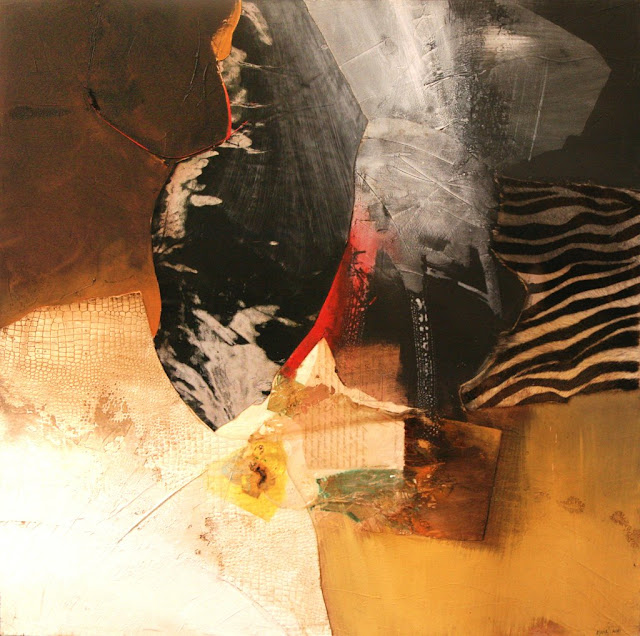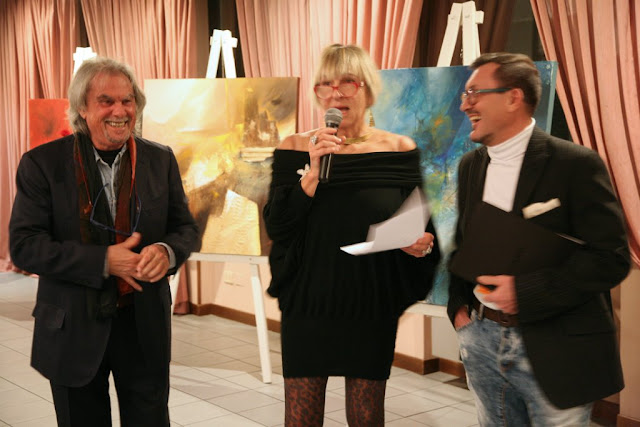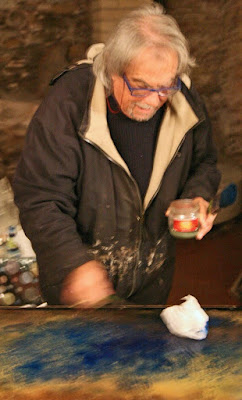Tanto tempo fa Fausto Minestrini dipingeva paesaggi con maestria e grazia, e incontrava il favore del pubblico vendendo alla grande. Ma un giorno incontrò Burri e questi gli chiese se non si annoiava... Così iniziò il suo percorso informale ed ogni suo quadro è stato un'avventura, un viaggio fatto con curiosità e sospinto da passione costante. La sua ricerca nuova e libera si è espressa in cicli di approfondimento instancabile da un lato di tecniche e materiali, dall'altro di temi. Anche se Fausto riconosce un debito di gratitudine a Burri e a De Gregorio, suo caro e compianto amico, la sua strada è totalmente originale. Fausto cerca sempre nuove vie, come uno scalatore, e le percorre con grande rigore, ma anche con gioia infantile e direi quasi incoscienza.
Mette anima mediterranea in una concezione americana dell'arte informale che lui supera con un romanticismo di fondo che gli fa riversare sulla tela emozioni intense. Un dettaglio ricordato o presente, un merletto femminile, una rosa in boccio, una lettera antica danno l'avvio ad onde di emozioni colorate che investono la tela sovrapponendosi e infrangendosi, ma sempre creando armonia ed equilibrio.
Fondamentale è il suo rapporto con la natura, suggeritrice sempre di colori e di forme, maestra di bellezza. Con lei c'è anche una intesa magica e,quasi stregone, Fausto coltiva fiori e piante antiche e officinali, vivendo le miracolose metamorfosi delle stagioni.
Il passato che continua a vivere nel presente dell' antico mulino, La Roscia, in cui vive crea il fondo fertile e intrigante delle sue opere. Alcuni critici hanno citato in proposito Leonardo e gli alchimisti:
...le machie de' muri, la cenere del foco, le nuvole e i fanghi che destano l'ingegno a nove inventioni.
E Fausto ne trae ispirazione anche grazie all'uso raffinatissimo e brillante della tecnica mista: inserzioni di carte antiche, oggetti evocativi, frammenti di sacco, scritte sottratte al loro contesto, metalli e vetri, superfici riflettenti, limature, terre e oro. Ogni elemento è manipolato dall'artista-faber perché solo attraverso il processo creativo prende significato e si carica di senso nel suo mondo visionario.
Nelle miniere di sogni e di ricordi l'oro trova significati molteplici, un tesoro prezioso da raggiugere che richiama le pratiche alchemiche come pure le combustioni che del passato gli permettono di esorcizzare l'indicibile.
Guardando le sue opere, dobbiamo avventurarci come Alice lasciandoci cadere nella cavità del tronco e accettando di abbandonare i nostri punti fermi, i riferimenti consueti, per affrontare un viaggio-scoperta. Come ad Alice vengono offerti biscottini e bottigliette, a noi vengono offerti indizi, tracce da seguire... Ma un'ambiguità sommessa s'insinua nella lettura dei quadri che sono sempre più complessi di quanto appare inizialmente.
Per esempio, in Passaje para tu corazon una chiave di antica foggia ci invita quasi rassicurandoci, ma troppe storie dolorose iniziarono con tanta semplicità...
 |
| Passaje para tu corazon |
 |
| Per vederti meglio |
Per vederti meglio cita la favola di Cappuccetto Rosso, espressione piena di amore da parte della nonna ma carica di minaccia da parte del lupo camuffato. E' una frase d'amore che richiama anche l'inquietudine della famosa canzone dei Police: Every breath you take, I'll be watching you (Ti terrò d'occhio).
 |
| Vento tiepido |
 |
| Tango |
Così in Vento tiepido si richiama l'attimo fuggente della giovinezza e la musica lontana di Battisti.
In Tango una rosa ancora in boccio reca promesse mentre i colori si scatenano tra la passione e la violenza, un tuffo nell'ambiguità dei sentimenti primigeni.
Faro spento è il punto alto dal quale esplorare un mondo di nostalgia. E' spento ma la luce ancora viva dei ricordi aleggia intorno dolce e acre insieme.
 |
| Faro spento |
 |
| Notte del serpente |
 |
| Africa |
Notte del serpente ci immerge negli abissi dell'inconscio, liquide azzurrità piene di vitalità e di tranelli, mentre in Africa espode la fantasia infinita della natura nei suoi colori e disegni bizzarri: si aprono spazi d'infanzia e d'avventura, adrenalinici di paura e saturi di gridi e fruscii. Ma non è questo il mondo primitivo dentro di noi?
Tuono di luce esperimenta, come altre opere recenti, l'uso di luci interne all'opera stessa e il sentimento potente che le ispira trova ulteriore energia.
Fausto sintetizza la sua poetica con una frase semplice ma immensa: scrive che semplicemente cerca di dipingere il calore del sole, il colore del vento, il silenzio della luna.
Ma Fausto è anche generoso e ama tenere corsi ad aspiranti pittori per offrire loro le competenze tecniche necessarie perché possano esprimersi. I corsi, tenuti nel suo laboratorio (antro di Mago) sono amichevoli e pieni di allegria contagiosa. L'impegno è intenso ma gioioso.
Un'atmosfera di complicità, quasi di congiura, per arrivare lontano nella via della conoscenza e della bellezza.
 |
| Collegamento all'Album con tutte le foto della mostra e dell'atélier dell'Artista |
Fire, Clouds and Mud
Fausto Minestrini's Poetic Visions
A long time ago Fausto Minestrini painted landscapes with skill and grace, and met the favor of the public by selling successfully. But
one day he met Burri, who asked him if he was not bored ...
So Fausto started his informal journey and every painting has been an adventure, a travel made with curiosity and driven by constant passion. His new and free research has been expressed in cycles of tireless research, on one hand on techniques and materials, and on the other on themes. Even if Fausto recognizes a debt of gratitude to Burri and De Gregorio, his dear and late friend, his path is totally original. Fausto always looks for new ways, like a climber, and runs them with great rigor, but also with childish joy and a sort of recklessness.
He puts mediterranean soul in an american conception of informal art that he overcomes with a background of romanticism that makes him pour intense emotions onto the canvas. A remembered or present detail, a feminine lace, a bud rose, an ancient letter give rise to waves of colored emotions that invest the canvas overlapping and breaking, but always creating harmony and balance.
Its relationship with nature is fundamental, always a suggestion of colors and shapes, a beauty teacher. With nature there is also a magical agreement and, almost a sorcerer, Fausto cultivates ancient and medicinal flowers and plants, living the miraculous metamorphosis of the seasons.
The past that continues in the present of the ancient mill, La Roscia, in which he lives, creates the fertile and intriguing background of his works. Some critics have quoted Leonardo and the alchemists about it:... the stains on the walls, the ash of the fire, the clouds and the muds that arouse the talent to new inventions.
And Fausto draws his inspiration also thanks to the refined and brilliant use of mixed techniques: insertions of ancient papers, evocative objects, sack fragments, writings subtracted from their context, metals and glass, reflecting surfaces, filings, sands and gold. Each element is manipulated by the artist-faber because it takes meaning only through the creative process and is charged with sense in his visionary world.
In the mines of dreams and memories gold finds multiple meanings, a precious treasure to be reached that recalls alchemical practices as well as the combustions that allow him to exorcise the unspeakable of the past.
Looking at his works, we must venture like Alice letting ourselves fall into the trunk cavity and agreeing to abandon our fixed points, the usual references, to face a journey-discovery. As Alice is offered biscuits and bottles, we are offered clues, traces to follow... But a subdued ambiguity insinuates in the reading of the paintings that are always more complex than initially appears.
For example, in Passaje para tu corazon, an old-fashioned key invites us almost reassuringly, but too many painful stories began with such simplicity...
To see you better cites the tale of Little Red Riding Hood, an expression full of love by her grandmother but full of threat from the camouflaged wolf. It is a phrase of love that also recalls the restlessness of the famous Police song: Every breath you take, I'll be watching you.
Likewise in The lukewarm wind the fleeting moment of youth and the distant music of Lucio Battisti are recalled. In Tango a rose still in bloom brings promises while the colors are unleashed between passion and violence, a dip in the ambiguity of primitive feelings.
Off lighthouse is the high point from which to explore a world of nostalgia. It is off but the still vivid light of memories hovers around sweet and sour at one time.
Night of the snake plunges us into the abysses of the unconscious, liquid azurness full of vitality and tricks, while in Africa the infinite fantasy of nature expires in its bizarre colors and designs: spaces of childhood and adventure, adrenaline of fear open up and saturated with shouts and rustles. But is this not the primitive world within us?
Thunder of light experiences, like other recent works, the use of lights inside the work itself and the powerful feeling that inspires them finds further energy.
Fausto summarizes his poetics with a simple but immense sentence: he writes that he simply tries to paint the heat of the sun, the color of the wind, the silence of the moon.
But Fausto is also generous and likes to teach lessons to aspiring painters, to offer them the technical skills necessary to express themselves. The courses, held in his laboratory (Wizard's cave) are friendly and full of contagious happiness. The commitment is intense but joyous in an atmosphere of complicity, almost of conspiracy, to get far in the path of knowledge and beauty.
So Fausto started his informal journey and every painting has been an adventure, a travel made with curiosity and driven by constant passion. His new and free research has been expressed in cycles of tireless research, on one hand on techniques and materials, and on the other on themes. Even if Fausto recognizes a debt of gratitude to Burri and De Gregorio, his dear and late friend, his path is totally original. Fausto always looks for new ways, like a climber, and runs them with great rigor, but also with childish joy and a sort of recklessness.
He puts mediterranean soul in an american conception of informal art that he overcomes with a background of romanticism that makes him pour intense emotions onto the canvas. A remembered or present detail, a feminine lace, a bud rose, an ancient letter give rise to waves of colored emotions that invest the canvas overlapping and breaking, but always creating harmony and balance.
Its relationship with nature is fundamental, always a suggestion of colors and shapes, a beauty teacher. With nature there is also a magical agreement and, almost a sorcerer, Fausto cultivates ancient and medicinal flowers and plants, living the miraculous metamorphosis of the seasons.
The past that continues in the present of the ancient mill, La Roscia, in which he lives, creates the fertile and intriguing background of his works. Some critics have quoted Leonardo and the alchemists about it:... the stains on the walls, the ash of the fire, the clouds and the muds that arouse the talent to new inventions.
And Fausto draws his inspiration also thanks to the refined and brilliant use of mixed techniques: insertions of ancient papers, evocative objects, sack fragments, writings subtracted from their context, metals and glass, reflecting surfaces, filings, sands and gold. Each element is manipulated by the artist-faber because it takes meaning only through the creative process and is charged with sense in his visionary world.
In the mines of dreams and memories gold finds multiple meanings, a precious treasure to be reached that recalls alchemical practices as well as the combustions that allow him to exorcise the unspeakable of the past.
Looking at his works, we must venture like Alice letting ourselves fall into the trunk cavity and agreeing to abandon our fixed points, the usual references, to face a journey-discovery. As Alice is offered biscuits and bottles, we are offered clues, traces to follow... But a subdued ambiguity insinuates in the reading of the paintings that are always more complex than initially appears.
For example, in Passaje para tu corazon, an old-fashioned key invites us almost reassuringly, but too many painful stories began with such simplicity...
To see you better cites the tale of Little Red Riding Hood, an expression full of love by her grandmother but full of threat from the camouflaged wolf. It is a phrase of love that also recalls the restlessness of the famous Police song: Every breath you take, I'll be watching you.
Likewise in The lukewarm wind the fleeting moment of youth and the distant music of Lucio Battisti are recalled. In Tango a rose still in bloom brings promises while the colors are unleashed between passion and violence, a dip in the ambiguity of primitive feelings.
Off lighthouse is the high point from which to explore a world of nostalgia. It is off but the still vivid light of memories hovers around sweet and sour at one time.
Night of the snake plunges us into the abysses of the unconscious, liquid azurness full of vitality and tricks, while in Africa the infinite fantasy of nature expires in its bizarre colors and designs: spaces of childhood and adventure, adrenaline of fear open up and saturated with shouts and rustles. But is this not the primitive world within us?
Thunder of light experiences, like other recent works, the use of lights inside the work itself and the powerful feeling that inspires them finds further energy.
Fausto summarizes his poetics with a simple but immense sentence: he writes that he simply tries to paint the heat of the sun, the color of the wind, the silence of the moon.
But Fausto is also generous and likes to teach lessons to aspiring painters, to offer them the technical skills necessary to express themselves. The courses, held in his laboratory (Wizard's cave) are friendly and full of contagious happiness. The commitment is intense but joyous in an atmosphere of complicity, almost of conspiracy, to get far in the path of knowledge and beauty.












Nessun commento:
Posta un commento
Nota. Solo i membri di questo blog possono postare un commento.